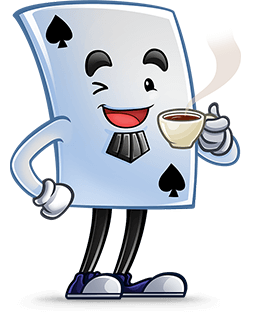How to Play Forty Thieves
The goal of Forty Thieves Solitaire is to build all eight foundation piles from ace to king by suit. You do this
by sequencing cards in the tableau and drawing from the stockpile.
Setup
The game uses two 52-card decks of standard playing cards and is made up of four different areas.

-
The tableau houses 40 face-up cards (ten columns of four cards each). You sequence cards in the
tableau in descending order by suit but can only move one card at a time. Only the last card in a tableau
column is playable.
-
The stockpile holds 64 cards, and you flip cards from the stockpile to the waste pile when you get
stuck. Face-up cards in the waste pile can be moved to the tableau or foundations.
- The foundation piles are built from ace to king by suit. You must complete all eight to win.
Forty Thieves Solitaire Rules
While the tableau cards are face-up, allowing you to plan your moves, limited card movement and stockpile use
makes Forty Thieves a challenging Solitaire game. Here are the rules:

- Sequence cards in descending order by suit. For example, a 3♠ can be moved on top of a 4♠.
-
Only move one card at a time, not sequences. Even if cards are sequenced in descending order by suit,
you can’t move them as a group. So you wouldn’t be able to move the 4♠ and 3♠ onto a 5♠.
-
Only run through the stockpile once. You can’t flip the waste pile back into the stockpile and run
through the cards again.
-
Move waste pile cards to the tableau or foundation piles. The top card can be played into the tableau
or foundations as long as it follows the correct sequence.
-
Place any card in an empty column. Use empty columns to rearrange cards or place high ranking cards
in them to build long sequences.
-
Build foundation piles ascending from ace to king by suit. Start each foundation pile with an ace and
stack cards in order (A, 2, 3, 4, 5, 6, 7, 8, 9, 10, J, Q, K) to complete each pile.
Forty Thieves Solitaire Strategies
Forty Thieves is a difficult Solitaire card game, so use these strategies for better chances of winning.
-
Make a plan to move aces into the foundation piles. Identify where aces are in the tableau and make a
plan to start building foundation piles. If you don’t do this early in the game, you’ll likely be blocked
later.
-
Free up columns in the tableau. Since you can only move one card at a time, open columns are valuable
for rearranging cards. It can be useful to leave multiple columns open, especially when you’re nearing the
end of the game.
-
Don’t rush using waste pile cards at the beginning of the game. Since all cards are faceup, you know
what you're working with in the tableau. For example, if you have one 10♥ at the bottom of a column and a
9♥ buried in the tableau, moving another 9♥ into the tableau likely isn’t beneficial because you can’t
sequence both 9♥ onto the same 10♥. Moving cards from the waste pile to a tableau pile just because the
move is available may clutter your board.
-
Focus on vacating the waste pile in the latter part of the game. Early on, it’s usually best to leave
waste pile cards alone unless they create clear progress, since tableau space is limited. As the game
progresses and you gain more room to maneuver, it becomes critical to start clearing the waste, especially
if low ranking cards are buried. You can’t win if needed cards are stuck there.
Ready for more challenging games? We offer dozens of free card games online, from
Classic Solitaire to Forty Thieves variations like
Josephine.




